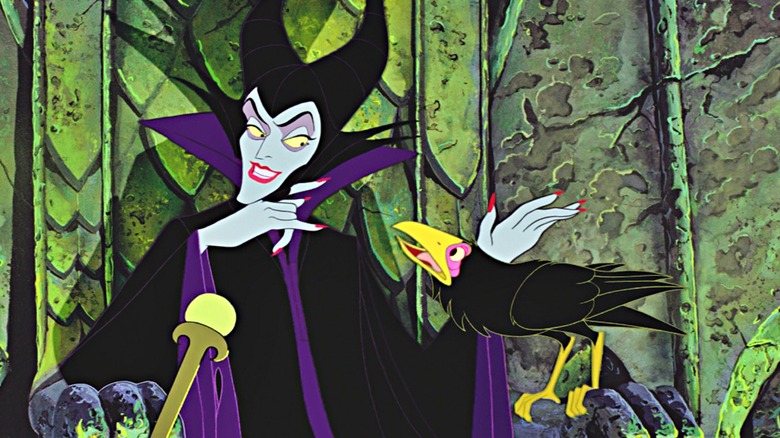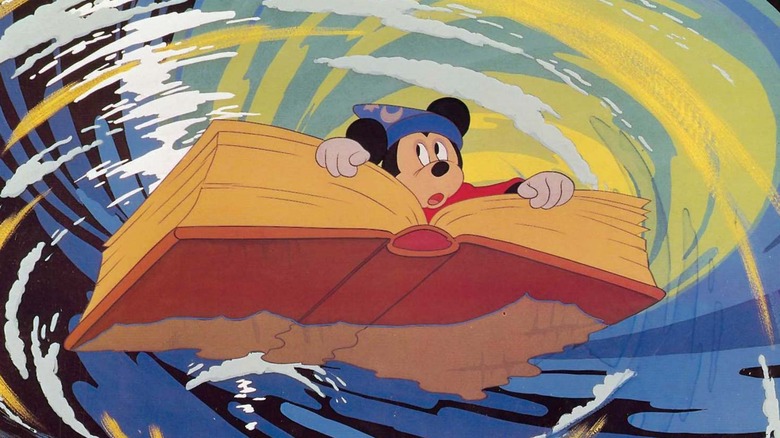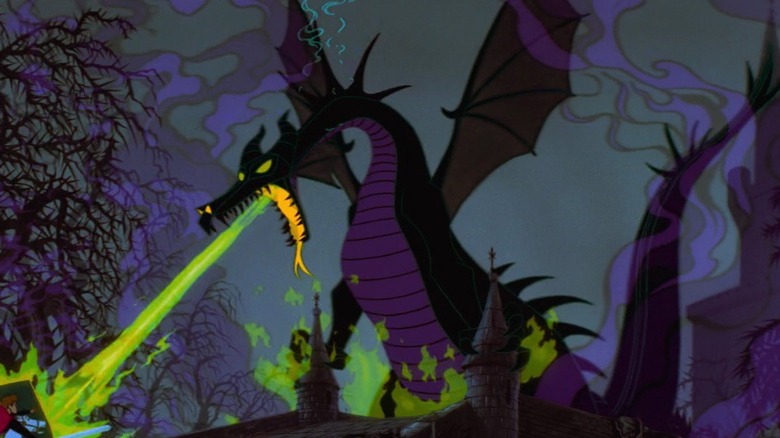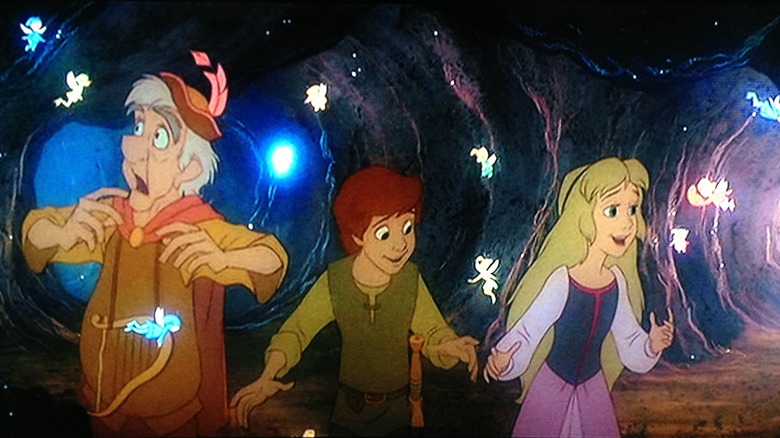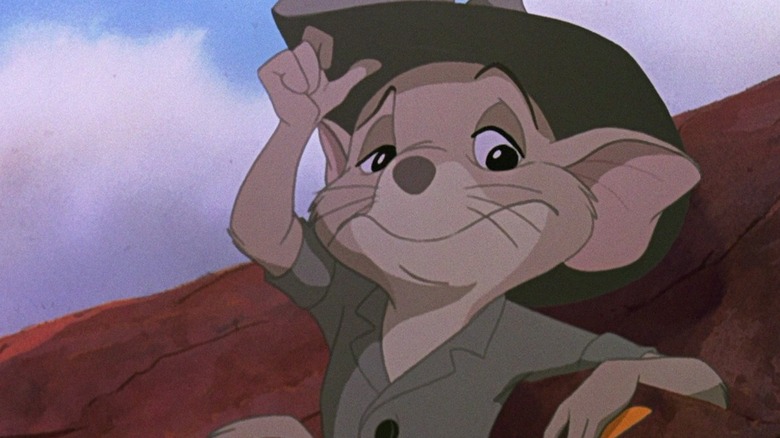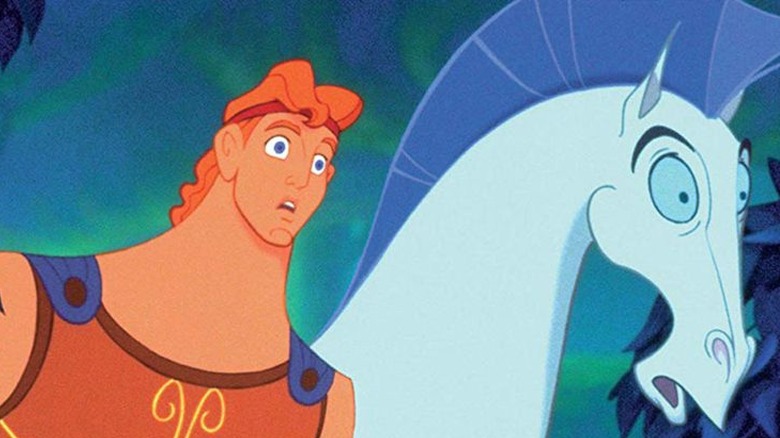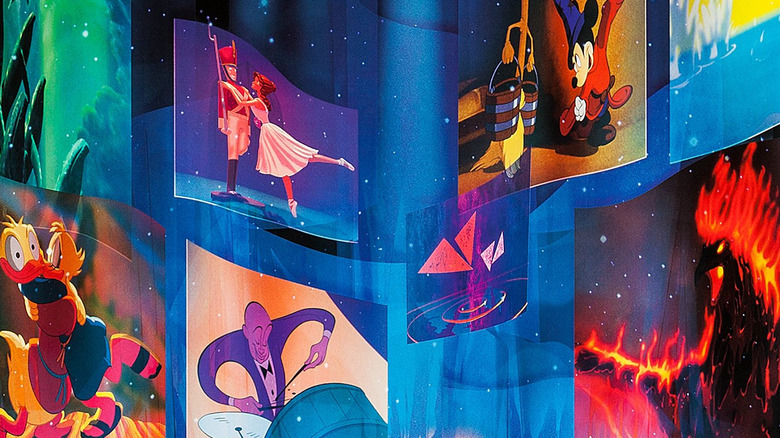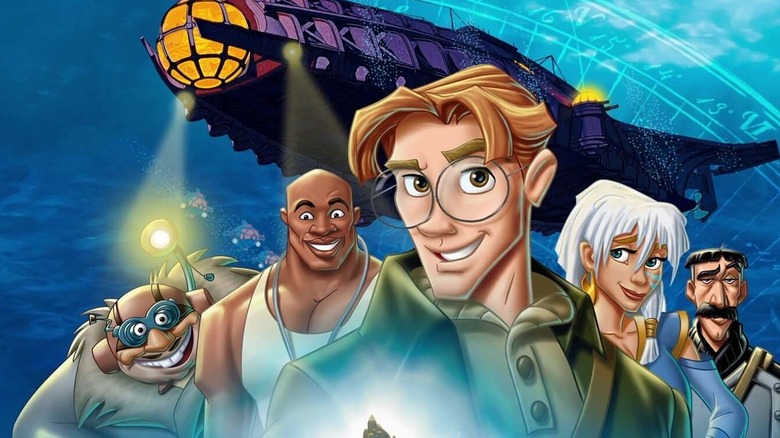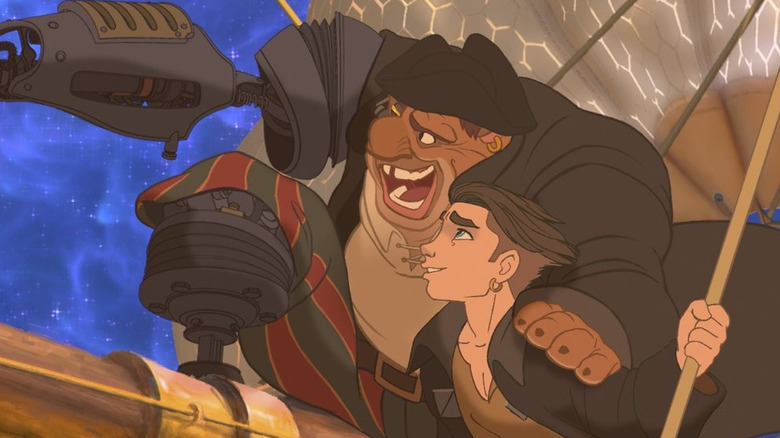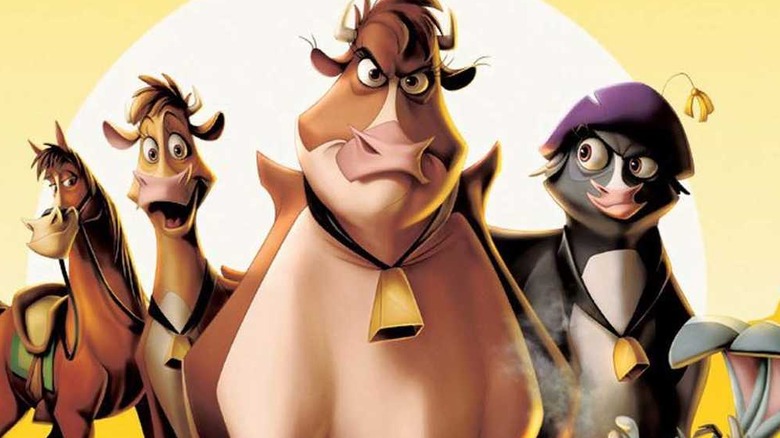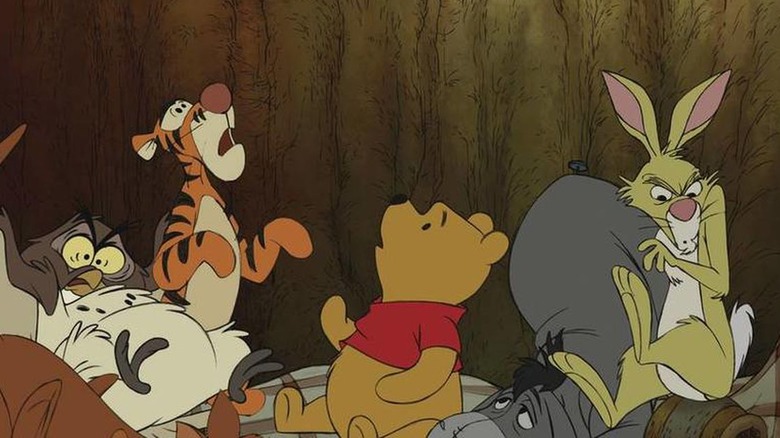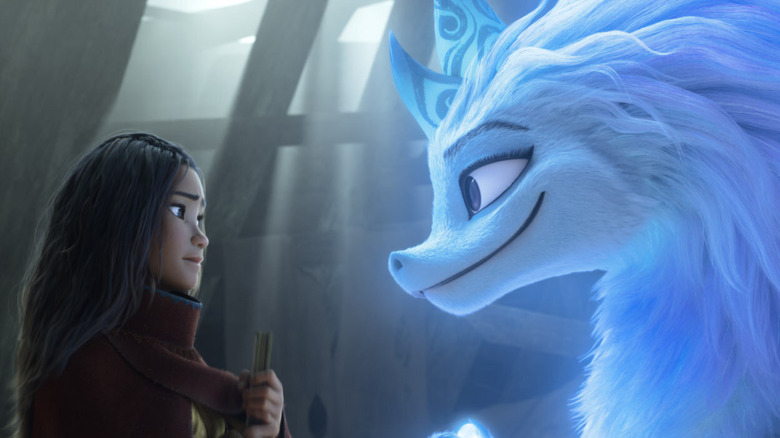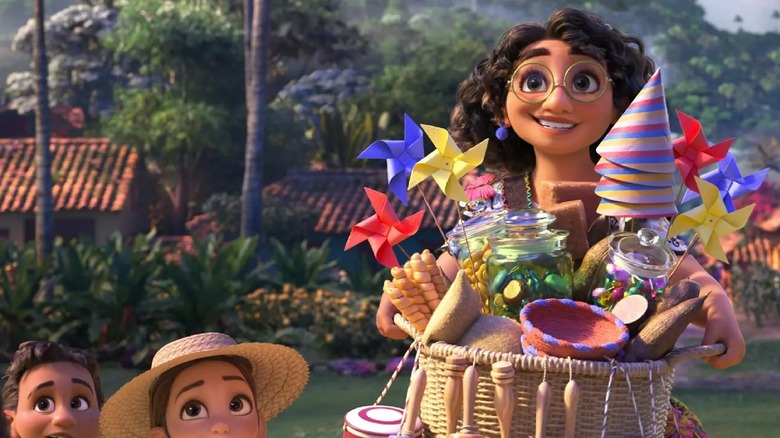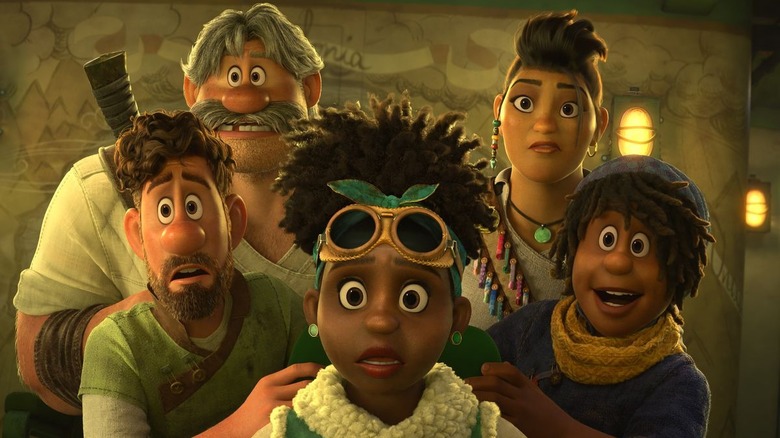The Real Reason These Animated Disney Movies Bombed
In the modern film landscape, animated Disney movies are a surefire recipe for box office success. Just look at how, per The Numbers, "Frozen II" grossed $1.44 billion at the worldwide box office in 2019. This trend of animated Disney movies making a sizeable box office impact dates back to the very first Walt Disney Animation Studios production, "Snow White and the Seven Dwarfs." According to History.com, that inaugural feature made enough money to become the biggest film in history up to that point.
In the 82 years since "Snow White" debuted, Disney Animation has released 57 further movies, but not every one of those titles has managed to score the same level as success as "Frozen II" and "Snow White." In fact, some capsized financially so greatly that they threatened the very existence of Walt Disney Animation Studios. They may be accustomed to cranking out hits, but even Disney Animation couldn't avoid the inevitability of creating a box office dud.
It should be noted that this list only considers the 58 films from the American version of the Walt Disney Animation Studios canon. This means no PIXAR Animation Studios titles or other animated titles distributed by Disney were considered for placement.
Fantasia (1940)
"Fantasia" was Walt Disney's baby. Walt Disney was so in awe of "Fantasia" that he once said, "'Fantasia' is timeless. It may run 10, 20 or 30 years. It may run after I'm gone. 'Fantasia' is an idea in itself. I can never build another 'Fantasia.' I can improve. I can elaborate. That's all," according to the Los Angeles Times.
Walt's passion did not translate into initial massive box office returns for "Fantasia." The film's first screenings at a roadshow engagement did not turn a profit thanks to the expensive costs of setting up a sound system known as Fantasound in theaters showing "Fantasia." Those costs, as well as World War II reducing the amount of overseas territories the film could play in, ensured that Walt Disney's passion project would struggle to turn a profit. To boot, the avant-garde nature of the feature initially turned off general moviegoers and even some critics. As noted by Smithsonian Magazine, "Fantasia" "lost more than the modern equivalent of $15 million and nearly drove the company into bankruptcy."
While "Fantasia" initially proved to be too costly and unorthodox to be successful right away, the film would find itself profitable decades later. A 1969 theatrical re-release saw "Fantasia" finally turning a profit, while a subsequent re-release in 1990 took in $25 million. Despite bombing in its first theatrical run," Fantasia" did indeed live up to Walt Disney's hopes of running "after I'm gone."
Sleeping Beauty (1959)
Today, "Sleeping Beauty" is seen as one of the crown jewels of Disney Animation. But in its initial 1959 release, "Sleeping Beauty" was an outright box office dud. In 1979, The New York Times observed that, "The film cost $6 million and grossed slightly more than $5 million. Mostly because of this film, Walt Disney Productions lost $1.3 million in 1959‐60, the first time it had lost money in a decade."
This New York Times piece observes that the reasons for "Sleeping Beauty's" underperformance remain a mystery. However, popular explanations for the project's struggles to initially connect with viewers are its distinct animation style as well as negative reception to the scariness of the film's main villain Maleficent. It's also worth noting that it's hard to imagine any film in 1959 being profitable enough with "Sleeping Beauty's" $6 million budget. For example, the second-highest-grossing movie of 1959 was "The Shaggy Dog," with a $9.6 million domestic haul, per Ultimate Movie Rankings. That's less than double the $6 million budget of "Sleeping Beauty," a clear showcase that any 1959 film would struggle to be profitable on "Sleeping Beauty's" then-gargantuan $6 million budget.
This box office performance lent an initial negative tinge to "Sleeping Beauty." However, this wasn't where the movie's story would end. Further theatrical re-releases in 1979 and in 1986 helped to restore the film's box office reputation, with the latter re-release managing to gross $15 million domestically (per Box Office Mojo).
The Black Cauldron (1985)
"The Black Cauldron" was intended to kick off a new era of animated Disney filmmaking. Channeling the darker tone of 1980s fantasy movies rather than classic Disney fare, this film was a departure from the norm of what animated Disney movies could be. In execution, "The Black Cauldron" ended up being a box office disaster for the studio. Grossing just $21 million domestically on a $44 million budget (according to The Numbers), "The Black Cauldron's" box office was so meager that it got outgrossed by fellow 1985 animated feature "The Care Bears Movie," while in 2010, Slate would dub "The Black Cauldron" "the movie that almost killed Disney Animation."
In September 2010, Jim Hill of Jim Hill Media did an in-depth dive into why "The Black Cauldron" failed at the box office. According to Hill, among the chief reasons the film failed to connect with audiences was that early reviews emphasized how dark and scary the production was. This ensured that the project turned away its primary demographic, kids, and their parents. A piece from Collider also has a quote from effects animator Dave Bossert noting that "The Black Cauldron" suffered financially because it was greenlit by Disney executives who were gone by the time the repeatedly delayed project was released, with the new executive team not being invested in the production.
The Rescuers Down Under (1990)
The first sequel in the Walt Disney Animation Studios canon, "The Rescuers Down Under" took the lead characters of "The Rescuers" to the Australian outback. Giving the Rescuers an adventure in Australia was meant to capture the box office power of then-recent Australian hits like "Crocodile Dundee." Unfortunately, "The Rescuers Down Under" did not have a g'day at the box office, with a $27.9 million domestic haul (per The Numbers).
Part of the problem "The Rescuers Down Under" faced was that, by the time it came out in November 1990, American audiences' fascination with Australia was waning. It had already been two years since "Crocodile Dundee II" made less than its predecessor. Another timing-related issue was that it had been 13 years since the original "Rescuers" had premiered. A bigger problem for "Rescuers Down Under" was that it had to face off against family movie juggernaut "Home Alone" in its opening weekend. That live-action feature soared financially, taking in $285 million over its domestic gross. "Rescuers Down Under" couldn't even hit ten percent of that gross in its domestic run.
Finally, as noted in the documentary "Waking Sleeping Beauty," Disney animation head Jeffrey Katzenberg ordered all "Rescuers Down Under" marketing to be pulled after its dismal opening weekend. This ensured that "The Rescuers Down Under" wouldn't be able to develop legs in the long run.
Hercules (1997)
During the early 1990s, Walt Disney Animation Studios was unstoppable. "Beauty and the Beast," "Aladdin," and "The Lion King" were all gigantic hits, each bigger than the last. But the hot streak started to fizzle after "The Lion King," with "Pocahontas" making noticeably less than the last two Disney Animation efforts. That issue became even more noticeable by 1997, when Hercules prominently signaled that Disney had lost some of its box office strength. Grossing $97 million domestically (per The Numbers), "Hercules" became the first Disney Animation title to gross under $100 million domestically since "The Rescuers Down Under" in 1990.
Just three weeks after the film's initial release, The New York Times reported that Disney was claiming that increased competition from fellow summer 1997 blockbusters like "Men in Black" was to blame for the underperformance of "Hercules." However, in the same piece, an unnamed Disney insider claimed that the box office woes of "Hercules" could be attributed to the fact that it only appealed to young children rather than audiences of all ages. As observed by "Forbes" in May 2020, "Hercules" also failed to be a brand name that attracts moviegoers. The lack of all-ages appeal and the struggles of making "Hercules" work as a big-screen attraction were the kind of hurdles even a guy who went from Zero to Hero couldn't overcome.
Fantasia 2000 (1999)
Nearly 60 years after its release, "Fantasia" recieved a sequel in the form of "Fantasia 2000." Only the second sequel in the Walt Disney Animation Studios canon, "Fantasia 2000" debuted exclusively in IMAX theaters on December 31, 1999. According to Box Office Mojo, over its opening weekend, "Fantasia 2000" took in $2.2 million from just 54 theaters. Unfortunately, that excellent box office wouldn't be replicated when it was released into general theaters six months later. According to The Numbers, "Fantasia 2000" eventually grossed $60.8 million domestically on an $80 million budget.
The fractured release method of "Fantasia 2000" doubtlessly hurt the title. Though meant to be an event you had to see in a theater, "Fantasia 2000" couldn't keep up its event status in the six-month between its IMAX debut and its general release premiere. What was a classy must-see in December 1999 was old news by June 2000. To boot, "Fantasia" has always been a niche property. It's not the norm for children's entertainment, and that meant "Fantasia 2000" was always going to struggle to compete against more conventional family-friendly fare released in the summer of 2000.
The more things change, the more they stay the same. In this case, "Fantasia 2000," much like its predecessor from six decades prior, struggled to translate its artistic ambitions into success at the box office.
Atlantis: The Lost Empire (2001)
During production, crew members working on "Atlantis: The Lost Empire" wore T-shirts that bore the phrase "Fewer Songs, More Explosions." This piece of attire embodied how "Atlantis" was being planned as a radical departure from usual Disney fare. This was further reflected in how "Atlantis" was an action/adventure film with set pieces straight out of a Ray Harryhausen film, while its character designs evoked the art of Mike Mignola rather than the visuals of "Aladdin." All these unique qualities, though, couldn't help "Atlantis" stand out at the box office.
Grossing just $84 million domestically on a $90 million budget, "Atlantis" became only the second post-1990 animated Disney movie (following "Hercules") to be released in the summertime and gross under $100 million domestically. The box office woes of "Atlantis" can be traced back to another family cartoon from the summer of 2001. In reporting its opening weekend box office, Entertainment Weekly observed that "Atlantis" was struggling to stay afloat in the face of box office overperformer "Shrek." It wasn't just that layered ogre that was causing trouble for "Atlantis," though. Entertainment Weekly also observed that word of mouth for "Atlantis" among moviegoers was not especially positive.
In the summer of 2001, the creative instincts of the "Atlantis" crew turned out to be right on the money. Moviegoers were indeed looking for something different from typical Disney films. However, that something different turned out to be a flatulent ogre rather than a retro action/adventure movie like "Atlantis: The Lost Empire."
Treasure Planet (2002)
Disney Animation had experienced box office duds before "Treasure Planet "sailed into theaters. However, none of them were as fatal as "Treasure Planet." Opening in November 2002, "Treasure Planet" opened to a dismal $12.1 million and grossed just $91.8 million worldwide on its massive $140 million budget (per The Numbers). The film was widely seen as a herald for the demise of hand-drawn animation, while its box office performance proved so momentously awful that the Los Angeles Times declared it one of the costliest box office flops in history in 2014.
Dating back to "Oliver & Company" in 1988, animated Disney movies have frequently reigned supreme over Thanksgiving. Why was "Treasure Planet" such a massive exception? Many have provided speculation over the answer to that question. Screenwriter Terry Rossio, who is credited for writing "Treasure Planet's" story, opined that turning "Treasure Island" protagonist Jim Hawkins into a teenager for alienated audiences. Meanwhile, November 2002 was packed with family films, including "The Santa Clause 2" and "Harry Potter and the Chamber of Secrets." Another pressing issue was that "Treasure Planet" was coming hot off a series of action-packed hand-drawn animated movies that had flopped, like "Titan A.E." and "Atlantis: The Lost Empire."
With so many other similar movies in the marketplace, "Treasure Planet" was unable to stand out as something special to audiences. Thus, this feature was unable to find the amount of booty necessary to justify its $140 million budget.
Home on the Range (2004)
At the time of its release, "Home on the Range" was a historic movie. This animated Western was intended to be the last Disney feature produced in hand-drawn animation. From this moment onward, computer animation would be used to realize Disney's animated productions. Disney's forays into hand-drawn animation did not get to go out in a blaze of glory with "Home on the Range," though. According to The Numbers, it grossed just $50 million domestically.
"Home on the Range's" release was plagued with a number of issues, including the fact that it came out in early April. The biggest Disney animation titles had always been released in either summertime or at Thanksgiving. Compounding the issues with that unusual release date was the fact that "Home on the Range" faced competition from another family movie. As noted by CBS News, moviegoers in the spring of 2004 chose familiar sequel "Scooby-Doo 2: Monsters Unleashed" over Disney's newest original musical. Those problems could have been overcome if "Home on the Range" had generated positive reviews. Unfortunately, the film received mixed marks from critics ,with a 53-percent Rotten Tomatoes critics rating, a far cry from the acclaim that greeted "The Lion King" a decade prior. Without any positive buzz to buoy it, "Home on the Range" was unable to attract a stampede of moviegoers.
Winnie the Pooh (2011)
Since 2005, every single feature from Walt Disney Animation Studios has made at least $97 million domestically. The lone exception to that rule is the 2011 feature "Winnie the Pooh," which made just $26.6 million domestically, per The Numbers. "Pooh's" box office woes could be attributed, in part, to the lack of specialness to a big-screen Pooh movie. Between 2000 and 2005, a trio of "Pooh" movies hit the big screen, each making less than its predecessor. Even with "Winnie the Pooh" being the first "Pooh" feature made by Walt Disney Animation Studios in nearly 35 years, moviegoers just weren't interested in more of the silly o'l bear on the big screen.
Then again, perhaps moviegoers would have been able to notice the project if it had gotten a better release date. "Winnie the Pooh" was released domestically on July 15, 2011. This put it smack-dab in between a number of big kids' movies. Three weeks prior, Disney's own "Cars 2" debuted, while two weeks later, "The Smurfs" would hit theaters. Worse yet, "Pooh" opened directly against "Harry Potter and the Deathly Hallows — Part 2," which scored the biggest opening weekend in history at the time. Facing off against wizards and family movies from its own studio, "Pooh" didn't stand a chance. This was in spite of the film receiving some of the best reviews of any movie released during the summer of 2011, with a 74 rating on Metacritic.
Raya and the Last Dragon (2021)
"Raya and the Last Dragon" was the first animated movie from Disney to be released in theaters in the wake of the COVID-19 pandemic shutting down movie theaters in March 2020. As if that wasn't enough historical significance for the feature to grapple with, "Raya" would also be the first ever Walt Disney Animation Studios title to be simultaneously unleashed on the big screen and in people's homes as a Disney+ Premium Access release. These were a lot of large obstacles and unique variables for "Raya" to deal with, which meant that, unsurprisingly, "Raya and the Last Dragon" didn't light up the box office. The movie only took in $116.1 million worldwide, including a small $54.7 million domestically.
A key problem for "Raya and the Last Dragon" in its domestic theatrical run was its theater count. Cinemark, one of the biggest theater chains in North America, initially refused to play "Raya and the Last Dragon" on its screens, ensuring that the film's theatrical footprint wasn't anywhere near as big as it could be. Plus, there was the fact that audiences could access "Raya" at home, albeit for a fee. It's no wonder "Raya and the Last Dragon" made less than classic Walt Disney Animation Studios titles, though it's still surprising its global box office haul was beneath other COVID-era kids movies like "The Croods: A New Age."
Encanto (2021)
It's impossible to comprehend now that "Encanto" wasn't initially a pop culture phenomenon. In the wake of "Encanto's" original songs making history on the Billboard charts or the film becoming a viral sensation after it hit Disney+, it's just difficult to imagine anything associated with "Encanto" being dubbed "a flop." But the initial box office run of "Encanto" did leave much to be desired, especially since this title, unlike animated Disney features like "Soul" or "Raya and the Last Dragon," wasn't getting sent to Disney+ in any way, shape, or form. This was a purely theatrical play and one that was opening over the Thanksgiving day weekend frame that had birthed some of Disney's biggest box office hits. Unfortunately, the film only grossed $230.7 million worldwide, a disappointing sum on a $150 million budget, and below the global box office haul of other Disney Animation titles like "Bolt."
Launching in the middle of rampant headlines about the Omicron variant couldn't have helped "Encanto's" box office chances, but Disney's decision to release the movie onto Disney+ around Christmas really hindered the film's box office potential. There was no way "Encanto" could lure people to the theater when it was available for free on that popular streamer. With that, this motion picture's box office run was obliterated. Thankfully for fans of this feature, "Encanto" would get a tremendous second life in pop culture once its theatrical run was finished.
Strange World (2022)
"Strange World," a big sci-fi adventure yarn from Walt Disney Animation Studios, wasn't just a box office disappointment for the studio. This production was an outright financial nightmare for all involved thanks to a five-day North American launch that failed to clear $20 million. For comparison's sake, Disney's 2017 animated Thanksgiving tentpole, "Coco," made more on its first Friday of release than "Strange World" did in its initial five days of existence. Just days after it opened, estimates began to emerge indicating that "Strange World" would end up losing $100 million for Disney in the long run.
When a movie like "Strange World" goes this awry at the worldwide box office, it's hard to pinpoint just one factor that led to its box office demise. Tepid posters and billboards that failed to emphasize the movies plot were likely a major factor. Reports of the movie's entire marketing campaign being strangely subdued also didn't help, nor did mixed responses from the moviegoers who did show up to watch "Strange World" in theaters. A confluence of events, including Disney's recent emphasis on putting new animated films on Disney+ first, hurt the theatrical prospects of "Strange World" and ensured it would make history at the box office in the worst possible way.
